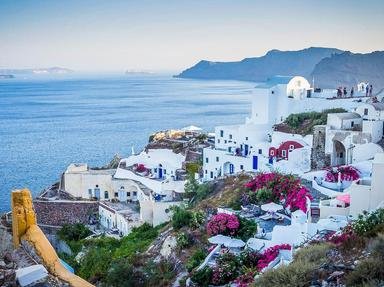Quiz Answer Key and Fun Facts
1. We start our tour on Europe's longest river, the Volga. The original Qolşńrif Mosque was destroyed by Ivan the Terrible in 1522. The inauguration of the new building (pictured) in 2005 kicked off the millennium celebrations for which city of 1.1 million people that stands on the banks of the Volga?
2. The Danube passes through many major cities on its way to the Black Sea. The picture shows the Hauptplatz (main square) in one of those cities, with its "Holy Trinity column" on the far right side. Which state capital of nearly 200,000 people, home to the world's oldest cake recipe, are we visiting?
3. The Rhine is one of the world's major north-flowing rivers. The Gothic-style Dom Tower (pictured) is the symbol of this city on the Rhine, and marks the location of the 1st-century Roman fortification around which the city developed. Which city is this, where the world's largest collection of medieval bells can still be heard today?
4. The Elbe rises in Czech Republic and flows northwards across Germany to the sea. On the way it passes through the city of Dresden, nicknamed 'The Jewel Box' because of its baroque and rococo historic centre. The pictured building, built in the 19th century, stands close to the Elbe, but what is its function of this magnificent building?
5. The Vistula flows 650 miles from the mountains in southern Poland to the Baltic Sea. The picture shows Długi Targ ("Long Market") and the 14th-century merchants' meeting place, Artus Court, which is the white building on the left. This is one of the most popular tourist destinations in which city, the largest in the metropolitan area known as 'Trˇjmiasto'?
6. The River Tagus rises in Aragon in northeastern Spain and crosses Spain and Portugal enroute to the Atlantic Ocean. This city of 80,000 (2014 estimate) on the Tagus has a history of steel production and, particularly, making the finest swords going back to Roman times. The picture shows 'Santa MarÝa la Blanca', Europe's oldest surviving synagogue. Which city are we now visiting?
7. The photograph shows the 15th century Ducal Palace, the oldest of the castles in the valley fed by this river. The castle overlooks the city of Nevers, capital of the former province of Nivernais. On which river, which rises in southern France and flows north then west to the Atlantic, does Nevers stand?
8. The Gota alv and Klaralven river system, which flows into the Kattegat on Sweden's southwestern coast, is the longest in the Nordic countries. It begins its 460-mile journey to the sea from the European Union's largest lake (pictured). Formed at the end of the last ice age about 10,000 years ago, which lake is this?
9. The River Po flows 424 miles eastwards from the Italian Alps to the Adriatic Sea. The picture shows the Palantine Gate, one of the world's best-preserved Roman gateways from the 1st century B.C. You can visit this archaeological wonder in a city of 900,000 (2012 estimate) located mostly on the left bank of the Po. Which city is this, Italy's first capital when the country was unified in 1861?
10. Rising in mid-Wales and flowing 220 miles east and south into the Bristol Channel, the River Severn is the longest in the U.K. The photograph shows the Cathedral Church of St Peter and the Holy and Indivisible Trinity, built close to the Severn on a site that was originally home to a 7th century abbey dedicated to Saint Peter. In which city, founded by the Romans in 97 A.D. as Colonia Glevum Nervensis, would you find this cathedral?
Source: Author
EnglishJedi
This quiz was reviewed by FunTrivia editor
Tizzabelle before going online.
Any errors found in FunTrivia content are routinely corrected through our feedback system.

